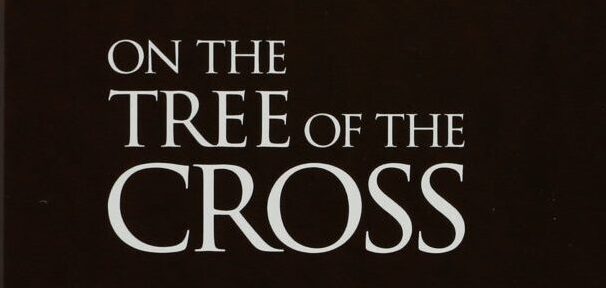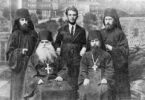This paper, presented at the Florovsky conference at Hellenic College & Holy Cross Greek Orthodox School of Theology, addresses the purely empirical data of publication history and does not pursue issues of theology or Church history in any explicit way.
The most complete available bibliography of the writings of Georges Florovsky (of those published during Florovsy’s lifetime) was compiled by Andrew Blane and appears in the book of essays dedicated to Fr. Florovsky’s memory that came out in 1993, the centenary of his birth [1]Andrew Blane, “The Published Writings Of George Florovsky,” in Andrew Blane (ed.), Georges Florovsky: Russian Intellectual, Orthodox Churchman (Crestwood, NY: St. Vladimir’s Seminary Press, … Continue reading. The bibliography lists 4 monographs, 180 essays, and articles, 125 book reviews, 35 published sermons, numerous forewords and introductions to works of others, as well as a fairly large number of entries in encyclopedias and handbooks. Slightly over half of these items originally appeared in English, with the next largest grouping of publications coming out in Russian. German, French, Bulgarian, Greek, Czech, Romanian, Swedish, and Spanish are the languages of publication spread over some three dozen other items.
Apart from the linguistic challenges this corpus represents, many of Fr. Florovsky’s articles appeared in limited-circulation periodicals or specialized “Festschrift”-type volumes that are tough to locate. But access to his writings has been steadily improving with the growing number of available reprints and translations as well as with several completed compilations and at least one ongoing project. It is to the theme of compilations that this essay is devoted.
The earliest and most ambitious – but also the most problem-plagued – compilation is the one launched in 1972 by the Belmont, Massachusetts-based publishing company named Nordland, then headed by Richard Haugh, a convert to Orthodoxy and a specialist in Church history. From the very beginning, Nordland announced its intention to produce what is called a Collected Works of Georges Florovsky. Fourteen volumes were published, and this edition will be referred to as CW in the present essay.
It is worth digressing briefly on the issue of producing a multivolume series featuring the works of a particular author. It involves a choice between two basic methods of arranging and sequencing the author’s works in a series of volumes – either the chronological or the thematic approach. Nordland wisely chose the thematic type of arrangement, which allows customers to acquire individual volumes without the need to invest in the entire series.
The attached appendix includes an outline of the contents of CW, while the remarks that follow address in greater detail certain issues in several specific volumes of this edition.
We know from various sources that Fr. Georges was pleased with the first two volumes of the series. He was impressed with Richard Haugh’s energy and enthusiasm, and we must assume that at the beginning there was considerable consultation between him and Richard Haugh about the choice of texts and the overall structure of the proposed series. But for unknown reasons, the consultation seems to have lapsed soon thereafter, and Florovsky was startled and dismayed upon realizing that certain changes had been made to some of his texts in volumes three and four without his knowledge or approval. The most damaging one involved the title of Florovsky’s Ingersoll lecture of 1951. This is a yearly and highly prestigious endowed lecture delivered at Harvard that always has the concept of immortality as its principal theme. Florovsky’s talk was accordingly titled “The Resurrection of Life,” but in Volume Three the title was changed to “The ‘Immortality’ of the Soul.” The most distressing aspect of the new title for Florovsky was that the word “Immortality” had for some reason been enclosed in quotes, thus imparting a troubling and utterly inappropriate note of artificiality to the concept. Nothing could have been further from Florovsky’s intention. While we do not have specific information on other instances of changes that displeased Florovsky, the fact is that he was upset enough to turn to a lawyer who sent a stern letter to Nordland, formally demanding that everything had to be submitted to Florovsky for clearance before being set in print. The lawyer’s letter, a copy of which remains in Florovsky’s papers, was sent on July 23, 1979, a time when Fr. Georges was anticipating the next volume in the CW series. But Florovsky died some three weeks later, on August 11, 1979, and the letter had no practical effect in terms of the ten volumes of the CW that appeared after this date.
Volume Five (1979) consists of a massively annotated translation of the first half of Florovsky’s famous Ways of Russian Theology (Пути русского богословия). The translation seems to be reliable, but the second half of the work appeared only after a gap of eight years because Nordland Publishing Company had to declare bankruptcy in 1984 and formally closed its doors. The indefatigable Richard Haugh managed to put together another firm, named the Büchervertriebsanstalt (based in Vaduz, the capital of the principality of Liechtenstein) and in 1987 brought out the second half of Ways of Russian Theology followed in the same year by four volumes of translations of Florovsky’s published lectures on patristics that he had given at the St. Sergius Theological Institute in Paris. The quality of the translation here is very uneven, no doubt related to the precipitous publishing schedule involved.
The last four volumes of this CW, namely Volumes 11, 12, 13, and 14, unfortunately, illustrate an almost extravagant departure from any reasonable idea of what constitutes anything that deserves to be called a Collected Works. Thus, for example, Volume 11, titled Theology and Literature features 15 texts on various Russian writers and literary groups, yet 4 of these 15 are verbatim extracts from Ways of Russian Theology, in other words, from material already published in Volumes 5 and 6. These extracts are here given independent titles as though they were separately published entities: “The Tortuous Religious Path of Gogol”, “The Evolution of the Dostoevskian Concept of Human Freedom”, “The Rationalistic Religion of Tolstoy”, and “The Crisis of Faith in Turn-of-the-Century Russian Poetry”.
But that is not all. Volume 11 contains a total of 200 pages, however, 47 pages out of that total are taken up by an appendix containing three articles by Richard Haugh, focused on aspects of the works of Dostoevsky and Tolstoy. These articles are quite interesting in their own light, but needless to say they do not belong in a CW of the writings of Georges Florovsky. The appendix is prefaced by the following note, allegedly from the publisher:
The articles in the appendix are included for two reasons. First, Fr. Florovsky was interested in the research and writing of Dr. Haugh. Fr. Florovsky had read several of Dr. Haugh’s writings in theology, literature, history and philosophy and was enthusiastic about them. It was not the first time that Fr. Florovsky had expressed himself publicly on the work of Dr. Haugh. About Dr. Haugh’s book entitled Photius and the Carolingians: The Trinitarian Controversy, Fr. Florovsky wrote that the book is «one of the major contemporary contributions to the history of Christian doctrine».[2]2] Quoted from the blurb on the dust cover of Haugh’s Photius book.
Fr. Florovsky wrote that Dr. Haugh’s article on “Hawthorne and Dostoevsky” (contained in the appendix of volume eleven) was «the most penetrating and perceptive work on a subject poorly handled previously. (…) To my knowledge, the theological background of the worlds of both Hawthorne and Dostoevsky – and by extension, to a portion of the world of American literature, has never before been handled with such competence…»
It pains me to publicize these comments, shockingly inappropriate intrusions as they are in a volume of works of a renowned author, but it seems to me very necessary to alert all those who are interested in Florovsky to the outlandish quirks of this edition (which, I note, is still in print according to the Amazon website).
Volume 12, titled “Philosopy,” also features an appendix with a Haugh article, this one on Solzhenitsyn. But at least the volume presents authentically new materials from the Florovsky corpus, albeit in sadly inadequate form. The most serious example noted concerns the 1926 essay titled “The Metaphysical Premises of Utopianism.” This lengthy text contains five sections in the original, whereas the published translation presents only four of them, with the concluding section five (some six pages in length) missing entirely. While I have not examined the translated sections in terms of their fidelity to the original, I must note that if the editor let pass an omission as egregious as this, it is pretty clear that no systematic check of the translation was carried out.
Volumes 13 and 14 address issues bearing on ecumenism and here the textological muddle reaches some kind of apogee. The titles of Florovsky’s articles are almost always changed, and the original forms are nowhere indicated. Thus Florovsky’s 1955 piece titled “Christ and His Church” becomes “On the History of Ecclesiology”, or two Florovsky texts “Togetherness in Christ” and “Primitive Tradition and the Traditions” (both 1962) are combined into “The Historical Problem of a Definition of the Church” with no indication of that fact. Breaking up Florovsky’s texts is the more common modus operandi, however. Thus the 1933 Russian essay on the problems raised by the issue of Christian reunion (“Проблематика христианского воссоединения”) has been turned into two essays in the translation. The first half appears in Volume 13 as “The Problematic of Christian Reunification”, while the second half is placed into Volume 14 under the title of “Rome, the Reformation, and Orthodoxy.” There is also instances of padding in the manner that this was done in the “Literature and Theology” volume: a lengthy (43 pp.) text in Volume 14 of the CW titled “Early Russian Ecumenism” is actually an extract from Ways of Russian Theology where it is that book’s ch. 2 (“The Encounter with the West”) that appears in Volume 5 of the CW.
The late Fr. Matthew Baker told me that over the years he had tracked down all the original texts from which the contents of Volumes 13 and 14 are derived. I must confess that I did not have the patience to go through a similar exercise. But I believe I have said enough to warn readers about the acute textual inadequacies of the last four volumes. I might also add with the four Ecumenism volumes have not to my knowledge served as a basis for any translations, perhaps for the reason that both Russian and Greek theologians tend to view the issue of ecumenism with extraordinary caution. In my opinion, they have nothing to fear and much to gain from the genuinely Orthodox views on this subject that are expressed in the texts of Fr. Georges Florovsky. But of course, it is crucial to stick to the authentic articles, not to the mixture of excerpts that are presented in the CW.
The major compilations in other languages are listed in the Appendix. To my knowledge, there are three collections in Greek, five in Russian and one in German. There is also a new English-language collection in preparation, due to appear in the fall of 2019.
APPENDIX
Compilations of Works by Georges Florovsky (As of May 2016)
1. COLLECTED WORKS in English, 14 volumes, 1972-1989. Published by Nordland (1972-79):
–vol. 1 (1972): Bible, Church, Tradition …………… – 7 items
–vol. 2 (1974): Christianity and Culture ……………– 9 items
–vol. 3 (1976): Creation and Redemption …………. – 12 items
–vol. 4 (1975): Aspects of Church History ………… – 12 items
–vol. 5 (1979): Ways of Russian Theology I ………– chs. 1-5
Published by Büchervertriebsanstalt (1987-89):
–vol. 6 (1987): Ways of Russian Theology II……… – chs. 6-9
–vol. 7 (1987): East. Church Fathers of the 4th C. …… – 13 chs.
–vol. 8 (1987): Byz. Fathers of the 5th C. ……………. – 18 chs.
–vol. 9 (1987): Byz. Fathers of the 6th to 8th C. ……….. – 7 chs.
–vol.10 (1987): Byz. Ascetic & Spiritual Fathers …. – 14 chs.
–vol.11 (1987): Theology and Literature …………. – 15 items
(Of these 15 items, 4 are texts drawn from Ways of Russian Theology; in addition, an “Appendix” contains two articles on aspects of Dostoevsky and one on Tolstoy by Richard Haugh. This is explained in a “Note from the Publisher”)
–vol.12 (1989): Philosophy …………….…………. – 15 items
(An “Appendix” contains Haugh’s article on Solzhenitsyn and an explanatory “Note from the Publisher.”)
–vol.13 (1989): Ecumenism I: A Doctrinal Approach …– 6 parts
(The parts are thematically ordered and made up of either full Florovsky texts or of extracts from various articles)
–vol.14 (1989): Ecumenism II: A Historical Approach … –3 parts
(A mixture of full texts and excerpts. One item is drawn from Ways of Russian Theology.)
2. Greek language compilations:
A. [Theological Treatises] tr. Panyotis C. Christou. (Thessaloniki: Patriarchal Inst. for Patristic Studies, 1972). 4 arts., no translations from CW
B. [Themes in Orthodox Theology] tr. by Stil. Papaleksandropoulos et al. (Athens: Artos Zoes, 1973). 12 arts., no translations from CW. (List: Blane, p. 373)
C. [Anatomy of Problems of Faith] tr. by archimandrite Meletios Kalamatos (Thessaloniki: Regopoulos, 1977). 5 arts., no translations from CW. (List: Blane, p. 375)
3. Russian language compilations:
A. Из прошлого русской мысли [Selections from Russian Intellectual History] Compiled by M.A. Kolerov et al. (Moscow: Agraf, 1998). 24 arts., all originally appeared in Russian (all early, 1911-1930).
B. Догмат и история [Dogma and History] Compiled by Egor Kholmogorov et al. (Moscow: St. Vladimir Brotherhood, 1998). 17 arts., 12 of them translations from CW, vols. 1-4.
C. Избранные богословские статьи [Selected Theological Articles] Compiled by Aleksandr Kyrlezhev et al. (Moscow: Probel, 2000). 17 arts., 10 of them translations from CW, vols.1-2.
D. Вера и культура [Faith and Culture] Compiled by I.I. Evlampiev (St. Petersburg: Khristianskii gumanitarnyi institut, 2002). 47 arts., 9 of them translations from CW, vols. 1-2.
E. Христианство и цивилизация [Christianity and Civilization] Compiled by I.I. Evlampiev (St. Petersburg: Russkaia Khristianskaia Gumanitarnaia Akademiia, 2005). This edition is identical in content and pagination with the one above.
4. German language compilation:
Sobornost. Kirche, Bibel, Tradition. (München: Kyril und Method Verlag, 1989). All 7 items are translations from vol. 1 of CW.
5. Forthcoming compilation in English:
The Patristic Witness of Georges Florovsky: Essential Theological Writings. Compiled, edited and introduced by Brandon Gallaher and Paul Laduceur; Preface by Met. Kallistos Ware (London etc.: T&T Clark, expected in 2019). Will contain 19 arts.
- Alexis Klimoff, On the Sophiological Controversy of the 1930s
- Georges Florovsky: Excerpts from Two Letters to Alexis Klimoff
References











